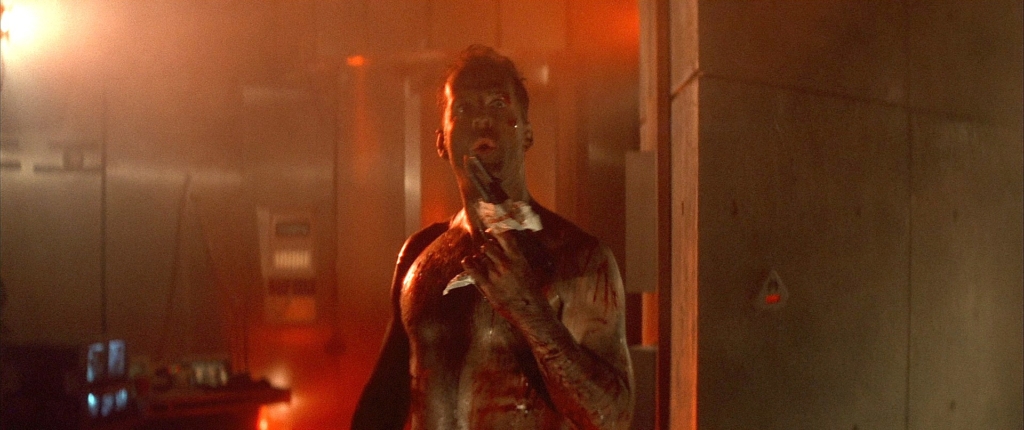
Bruce WIllis in Die Hard
Summer is the season of the Hollywood blockbuster — those slick, alluring productions, churned out with assembly-line regularity, that promise so many pleasures. Beyond an escape from rising temperatures and summer boredom, these movies offer glimpses into the boundaries of our imaginations, allow us to engage with our fantasies, and fill our screens with iconic characters, startling special effects, and thrilling plot twists. Plus, there’s popcorn.
One of the most central qualities of big budget Hollywood productions is heaping quantities of gun violence. And in light of the mass shootings that now seem to be routine exercises across the U.S., it has become difficult to ignore that this fantasy gun violence now appears in the context of highly publicized actual gun violence. As a result (and in spite of the fact that mass shootings predate the kind of violent media content that saturates our screens now), much of our public discourse around the issue of gun violence remains focused on trying to understand how (or if) violent media influences violent behavior. And while we put our energy into thinking about violent video games and movies, the news media continues its sensationalized coverage of mass shootings, and so another question emerges: How do we understand violent media content when the most violent media of all is the news media’s coverage of our violent reality?
Flag-draped coffins, bloodstained concrete, and graphic depictions of real violence maintain a prominent place within our culture. Via news broadcasts, we watched the bombing of Baghdad, the vicious beating of Rodney King, O.J. Simpson’s murder trial. We watch UFC events and we’ve seen the dehumanizing coverage of Tracy Morgan’s recent car accident. In our Facebook news feeds we see the cell-phone footage of violent fights that is now a staple of social media. In other words, we all know our reality is violent.
But even as real violence is increasingly available as consumable content, much of the discussion of media violence is still oddly determined to sort out Hollywood’s shoot-em’-ups. Chris Klimek, writing for NPR, recently compared the depictions of violence in The Raid 2 and Captain America: The Winter Soldier and concluded that, as opposed to the inconsequential, cleaned-up violence of Captain America, the explicit violence of the Raid 2 is preferable because “It’s . . . a more responsible way to depict gun violence than to pretend, as nearly all PG-13 shoot-’em-ups do, that firearms are masculinity-conferring toys that don’t end and/or ruin lives.” This type of discussion is typical of the current tendency to emphasize the influence of Hollywood’s fake violence rather than confront and analyze the impact of real violence.
While this discussion ignores the actual violence that is such a prominent part of our media landscape, what’s more disturbing is that, according to Klimek’s warped logic, the very real violence we see and hear about on television news — the kind that happens in our communities and then travels over the air to our TVs, free of the MPAA’s often arbitrary age restrictions — might be the most “responsible” of all.
Of course, the news media’s coverage of these shootings is anything but responsible, no matter what definition of responsibility you use. Dave Cullen’s book, Columbine, published ten years after one of the most infamous school shootings in U.S. history, explains in great detail just how much the media got wrong about that event in its immediate aftermath. And the news media has been botching stories ever since, filling its twenty-four hour channels and its magazine covers with speculation labeled as analysis and generalizations labeled as facts, all with the motivation of trying to shape the tragic mess into some kind of coherent story, the kind of thing that’s easy to consume and to understand, the kind of thing that sells. And so, just like in any other story, Hollywood blockbuster or not, it all becomes entertainment.
It is an extremely sad reality that our culture generates a staggering amount of gun murders on a daily basis. Even sadder still is the reality that these murders are being packaged and sold as entertainment. Just like Hollywood’s latest blockbuster, they are narrativized (we scramble for details leading to insight about the shooters’ characters and motivations), sensationalized, split up into sections between ads and formatted for our screens. If you want to see what this looks like, you don’t need to look far: the early response to the recent UCSB tragedy showcases many of these characteristic aspects of how the media covers mass shootings. For example, one CNN article, “Inside the Gunman’s Head,” draws heavily on Rodgers’s own writing in order to lazily approximate an abridged version of his life story. Even slightly more incisive online commentary has been unable to resist the urge to turn this event into a simple narrative about misogyny and privilege. Though it shouldn’t take a violent murder to bring these subjects into discussion, in immediately positing simplistic explanations for any event we’re also creating a narrative about gun violence. Being aware of narratives currently circulating is crucial. Our ability to think clearly about the issue of gun violence depends on our ability to recognize the kind of story we’re being told, in order to understand its construction and its implications.
The Hollywood-inflected, news-as-entertainment approach to covering these events leads to incredible distortions of reality. Some of these distortions are harmless, others are not. For example, the fact that mass shootings have actually decreased in recent years is simply not reflected in the news media’s coverage. Instead, continual coverage of these types of shootings warps reality by creating just the opposite impression. Conversely, we must also consider the tremendous amount of gun violence that generates no news coverage at all: murders that happen over petty drug deals, domestic conflicts, and small-scale botched robberies are less convenient for the shooter narratives we’re used to hearing — not to mention they arise the issues of classism and sexism, which we’re still uncomfortable discussing. In order to sell its stories, the media directs attention away from the bulk of the violence and focuses on the anomalies. The result is that, at the very least, we are composing an incredibly inaccurate picture of gun violence as a whole.
Money is one obvious reason why news coverage, which is in the business of selling stories, would seek to mimic Hollywood’s surefire profit-generating storytelling formulas. But we must remember that the media operates essentially as an adjunct of those in power. Therefore, what needs to be made more obvious is how these formulas and their limitations are shaping the ways we process and respond to the very real problem of gun violence. Good Guy with a Gun versus Bad Guy with a Gun is not just the overly simplistic and juvenile notion informing current approaches to gun control, it’s also the narrative arc of many of Hollywood’s bestselling franchises.
The news media’s consistent and deliberate framing of the issue of gun violence in terms of the stories of individuals with certain deviant or strange characteristics effectively limits the conversation to one about anomalous individuals having access to certain kinds of weapons. As long as our attention is held within this frame, a discussion of the larger, more important issues having to do with gun violence — issues of power, of equality, of our culture’s norms and values — remains impossible. Unless we start having this important discussion, there isn’t much hope for substantial change.
What’s missing from the debate over gun violence is the recognition that the power of our culture’s dominant narratives is at the heart of the issue. Stories presented by the media are so powerful that they modulate public opinion and have the ability to make the public more amenable to the kinds of democratic control that is wielded over it by those who stand to benefit from channeling public attention and sentiment in specific directions (for example, toward so-called “troubled” individuals and away from more systemic problems). The way gun violence is being narrativized sets rigid limitations on what is thinkable; it erects the arena within which the debate takes place, effectively eliminating any discussion that might lead down more productive paths.
How many recent shooters left writing and film designed to be discovered and broadcast? How many of them sought to use the media as a vehicle for their voice and ideas, hoping to become the posthumous stars of their own blockbusters? How many of them, however reclusive and private, felt unable to meet the expectations set, in part, by the character types that Hollywood peddles in — the strong, masculine heartthrob, as in Elliot Rodger’s case. How many of them might have sought help (or have been recognized as in need of help by others) if our cultural narrative about mental illness wasn’t so limited, wasn’t also a narrative about shame and isolation? And what about the majority of shootings — the ones you won’t find on national news? What kinds of frustration, desperation, anger, rage, and hopelessness might be part of those stories? We won’t know until we decide that these kinds of stories are worth telling, too.
What should be obvious is that our larger cultural narratives need to change. But if that seems like an unattainable or overly idealistic goal, we can at least work to change the way these events are covered by national news media. So what might these stories look like if they were presented differently? As a start, they could travel far beyond the narratives of the shooters who become the news’s stars. Dave Cullen has already suggested that we stop encouraging these performances by withholding the media spotlight, and while this seems like a good idea, people might be driven to perform even if the stage isn’t well lit. We will be better served by stories that don’t sensationalize, over-simplify, or distort the issues involved. Instead, these stories should look beyond the shooter and patiently investigate and illuminate the entire context so that we can become more than just scared or angry or enthralled by these stories and their protagonists.
But whatever the current story in the headlines may be, it’s clear that violence on the screen (real or fake) is just one small part of it. Our narratives can, and must, be fuller, truer, and better. The allure of predictable, comfortable formulas is strong, but unlike Hollywood blockbusters and our current narrative about gun violence, the best stories are expansive enough, thoughtful enough, and truthful enough to generate real empathy, to help us take a long, hard look at something and understand it more fully, and to help us understand what life is like outside of our own limited individual experiences. Narrative has incredible power. Unless we work to create better ones, I’m afraid we might find out much more about what happens when the power of storytelling is put to work against people, not for them.
This post may contain affiliate links.







